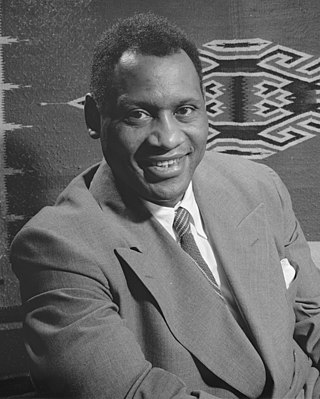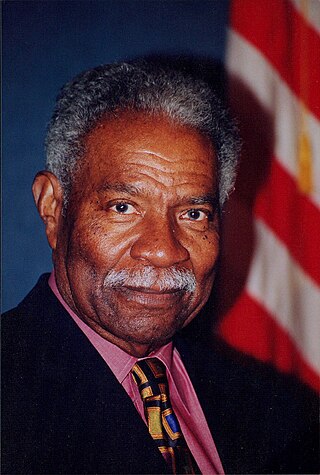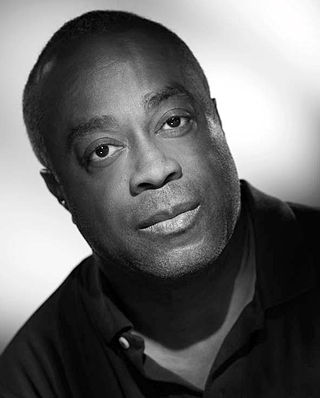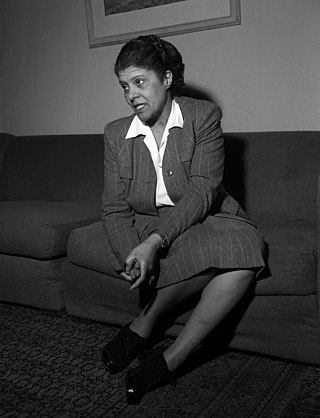External links
- Paul Robeson: Here I Stand at IMDb

- Paul Robeson: Here I Stand at WorldCat
- American Masters: Paul Robeson including full interviews
| Paul Robeson: Here I Stand | |
|---|---|
| Directed by | St. Clair Bourne |
| Written by | Lou Potter |
| Produced by | Chris Schultz |
| Starring | Paul Robeson Ossie Davis (Narrator) |
| Edited by | Will Lashley |
| Music by | Bill Toles |
| Distributed by | WinStar Home Entertainment |
Release date |
|
Running time | 117 minutes |
| Country | United States |
| Language | English |
Paul Robeson: Here I Stand is a comprehensive and award-winning documentary film that explores the life and career of Paul Robeson, the controversial African-American athlete-actor-singer-activist. It was directed by St. Clair Bourne for the PBS series American Masters . Spanning Robeson's whole life, it features interviews with Robeson himself, his son Paul Robeson Jr. and others close to its subject, celebrities, and several scholars on African-American cinema. It also includes extensive excerpts from Robeson's movies and musical recordings.

Paul Leroy Robeson was an American bass-baritone concert artist, stage and film actor, professional football player, and activist who became famous both for his cultural accomplishments and for his political stances.
The Peekskill riots took place at Cortlandt Manor, New York in 1949. The catalyst for the rioting was an announced concert by black singer Paul Robeson, who was well known for his strong pro-trade union stance, civil rights activism, communist affiliations, and anti-colonialism. The concert, organized as a benefit for the Civil Rights Congress, was scheduled to take place on August 27 in Lakeland Acres, just north of Peekskill.

Raiford Chatman "Ossie" Davis was an American actor, director, writer, and activist. He was married to Ruby Dee, with whom he frequently performed, until his death. He and his wife were named to the NAACP Image Awards Hall of Fame; were awarded the National Medal of Arts and were recipients of the Kennedy Center Honors. He was inducted into the American Theater Hall of Fame in 1994.

Charles Burnett is an American film director, film producer, writer, editor, actor, photographer, and cinematographer. His most popular films include Killer of Sheep (1978), My Brother's Wedding (1983), To Sleep with Anger (1990), The Glass Shield (1994), and Namibia: The Struggle for Liberation (2007). He has been involved in other types of motion pictures including shorts, documentaries, and a TV series.
"Ol' Man River" is a show tune from the 1927 musical Show Boat with music by Jerome Kern and lyrics by Oscar Hammerstein II. The song contrasts the struggles and hardships of African Americans with the endless, uncaring flow of the Mississippi River. It is sung from the point of view of a black stevedore on a showboat, and is the most famous song from the show. The song is meant to be performed in a slow tempo; it is sung complete once in the musical's lengthy first scene by the stevedore "Joe" who travels with the boat, and, in the stage version, is heard four more times in brief reprises. Joe serves as a sort of musical one-man Greek chorus, and the song, when reprised, comments on the action, as if saying, "This has happened, but the river keeps rolling on anyway."

Roy Ottoway Wilkins was a prominent activist in the Civil Rights Movement in the United States from the 1930s to the 1970s. Wilkins' most notable role was his leadership of the National Association for the Advancement of Colored People (NAACP), in which he held the title of Executive Secretary from 1955 to 1963 and Executive Director from 1964 to 1977. Wilkins was a central figure in many notable marches of the civil rights movement. He made valuable contributions in the world of African-American literature, and his voice was used to further the efforts in the fight for equality. Wilkins' pursuit of social justice also touched the lives of veterans and active service members, through his awards and recognition of exemplary military personnel.

William Garfield Greaves was an American documentary filmmaker and a pioneer of film-making. After trying his hand at acting, he became a filmmaker who produced more than two hundred documentary films, and wrote and directed more than half of these. Greaves garnered many accolades for his work, including four Emmy nominations.

Joshua Daniel White was an American singer, guitarist, songwriter, actor and civil rights activist. He also recorded under the names Pinewood Tom and Tippy Barton in the 1930s.

The Emperor Jones is a 1933 American pre-Code film adaptation of Eugene O'Neill's 1920 play of the same title, directed by iconoclast Dudley Murphy, written for the screen by playwright DuBose Heyward and starring Paul Robeson in the title role, and co-starring Dudley Digges, Frank H. Wilson, Fredi Washington and Ruby Elzy.

Sanders of the River is a 1935 British film directed by the Hungarian-British director, Zoltán Korda, based on the stories of Edgar Wallace. It is set in Colonial Nigeria. The lead Nigerian characters were played by African Americans Paul Robeson and Nina Mae McKinney. The film proved a significant commercial and critical success, giving Korda the first of his four nominations for Best Film at the Venice Film Festival.

St. Clair C. Bourne was an American documentary filmmaker, who focused on African-American subjects and addressed social issues. He also developed projects that explored African-American cultural figures, such as Langston Hughes and Paul Robeson. Not only was Bourne a towering figure in the documentary film world but also an activist, teacher, and organizer.
Paul Leroy Robeson Jr. was an American author, archivist and historian.

Eslanda "Essie" Cardozo Goode Robeson was an American anthropologist, author, actress, and civil rights activist. She was the wife and business manager of performer Paul Robeson.
The Tallest Tree in our Forest is a 1977 documentary film directed and written by Gil Noble, about singer, actor and activist, Paul Robeson. It was shot on 16mm film and was started shortly before Robeson's death at age 77 in 1976. The film features rare archival footage, interviews, and still photography from the twentieth century. The title is taken from a 1940s statement made by Mary McLeod Bethune describing Paul Robeson. The film was originally available in a three-part format for use on public-access television channels and in classrooms for ages fourteen and above.
Paul Robeson - Speak of Me As I Am is a 1998 documentary film directed by Rachel Hermer. It is a co-production of BBC Wales/New Jersey Public Television series produced by Richard Trayler-Smith and Max Pugh, about the life of singer, actor and activist, Paul Robeson. It features rare extensive archival footage of Robeson in the former Soviet Union, including footage of Robeson at Yalta with Nikita Khrushchev and many of Robeson's homes and landmarks as they look today. There are also interviews with Robeson's two main biographers, Lloyd Brown and Martin Duberman. As of 2009, Paul Robeson - Speak of Me As I Am is the most extensive documentary on Paul Robeson that the BBC has ever been involved with.

Here I Stand is a 1958 book written by Paul Robeson with the collaboration of Lloyd L. Brown. While Robeson wrote many articles and speeches, Here I stand is his only book. It has been described as part manifesto, part autobiography. It was published by Othello Associates and dedicated to his wife Eslanda Goode Robeson.
Entertainer and activist Paul Robeson's political philosophies and outspoken views about domestic and international Communist countries and movements were the subject of great concern to the western mass media and the United States Government, during the Cold War. His views also caused controversy within the ranks of black organizations and the entertainment industry.
The US congressional testimony by Jackie Robinson, the first African-American Major League Baseball player of the modern era, against the famous entertainer and international civil rights activist Paul Robeson, was an American Cold War incident. Its events were precipitated when, at an international student peace conference held in Paris on April 20, 1949, Robeson allegedly made a speech to the effect that African Americans would not support the United States in a war with the Soviet Union, due to continued second-class citizen status under United States law. This subsequent controversy caused the House Committee on Un-American Activities (HUAC) to investigate Robeson and Robinson, as a famed African-American baseball player, was called on to impugn Robeson.

(Here I Stand) in the Spirit of Paul Robeson is a public artwork by American artist Allen Uzikee Nelson, located at the intersection of Kansas Ave NW, Georgia Ave NW and Varnum St NW in the Petworth neighborhood in Washington, D.C., United States. It is a tribute to musician, actor, and social activist Paul Robeson.

Freedom was a monthly newspaper focused on African-American issues published from 1950 to 1955. The publication was associated primarily with the internationally renowned singer, actor and then officially disfavored activist Paul Robeson, whose column, with his photograph, ran on most of its front pages. Freedom's motto was: "Where one is enslaved, all are in chains!" The newspaper has been described as "the most visible African American Left cultural institution during the early 1950s." In another characterization, "Freedom paper was basically an attempt by a small group of black activists, most of them Communists, to provide Robeson with a base in Harlem and a means of reaching his public... The paper offered more coverage of the labor movement than nearly any other publication, particularly of the left-led unions that were expelled from the CIO in the late 1940s... [It] encouraged its African American readership to identify its struggles with anti-colonial movements in Africa, Asia, and the Caribbean. Freedom gave extensive publicity to... the struggle against apartheid."